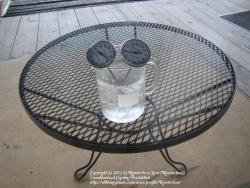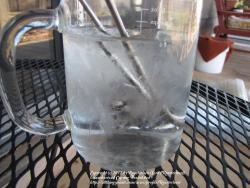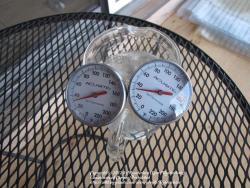Many of us store lily material in small dedicated unites. Thermometers should always be suspect for poor accuracy--All you have to do is check several of the same type hanging on the store rack. I recently checked eleven, hanging one behind the other in a big box store and the temperature ranged from 67'F to 79'F. Disgusting! And don't expect those digital units with remote sensors to do much better. They may show better agreement for unit to unit in the store at 72'F but take them home and see what you read at 32'F. The unit in my greenhouse runs 5.7'F low at 32'F actual on one sensor and 3.2'F low on the other sensor.
Truth is--no thermometer made, not even expensive Laboratory thermometers are 100% accurate throughout a wide temperature range. But we really DO need to know what our lily fridges are running at, right? Well, turns out one of the most accurate thermometers you can use, ends up being a cheap 'generic' dial type ( doesn't matter who's name is on it)--if your willing to do an interesting little experiment and make a tiny, simple adjustment. Follow me.
Dial Thermometer has adjustment nut at stem top. It can be losened slightly and the dial head can be rotated to exact temp. desired, then snugged back tight.
Edit: SPECIAL NOTE ADDED. For most precise calibration, I recommend using distilled or pure water. Certain well waters may contain harmless low levels of minerals like calcium, copper ions, etc. which could slighty lower the actual freezing point of the solution. Municipal water may also have other additive that have a similar affect.

Next I placed a glass beaker ( a 12 oz glass will do, too) of water and dial thermometers outside early in the morning when the temp. is 20'F or colder and I placed it outside a sliding door where I could keep an eye on it from inside, checking periodically for the sight of ice crystals. And I faced the dials toward ith inside so I could watch the temp. drop, also.

You can watch the ice crystals as they form in three dimensional--very beautifull. Some as long as needles, others like crystal chandeliers suspended in space. The entire contents will now stay at 32'F until it all frrezes so I've got enough time to make the adjustment and recheck to verify. These thermometers checked 3' and 5' high at 32'F


And and the now both read 32'F. Easy adjustment--got both correct the first time! Kinda fun!

Now I have a beaker with water a calibrated thermometer which I'll set in my fridge overnite and check in the morning; in fact, I'll check all four corners and the freezer section too. Finally, peace of mind!




